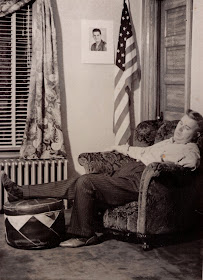These scenes are still in or near the KMT HQ we have featured in recent posts. We need to figure out precisely where this is.
The style of photomontage used here, with no margins and with prints cut at various angles, is reminiscent of what we have seen in the Kensington High yearbook design and the St. Luke's youth group newsletter. Apparently it was popular in the 1940s. Who did all this cutting and pasting for this photobook? Dad? His father, our JPZ? Mom? Mom having done it would explain all the photos of Dad!
Detailed information about the terrain was vital to planning airstrips and a possible future land invasion, the latter a dreadful prospect. The photo team does not appear to have wide-angle lenses. They take a series, note the exposure numbers, and cut and paste prints together to produce a wide view of terrain.
Posed shots like the one below are hints that they have a lot of time on their hands. No doubt they also need to adapt their techniques to local conditions of light and dust, set up their darkroom facilities, and decide on the best developing and printing techniques.
They are also making contact with local Chinese, setting up training sessions, setting up reconnaissance missions and protocols for reporting, and recording terrain farther and farther out from base.
Who is this? Who is this?



















































